Real(i)ty Check
An analysis of real estate prices across different cities in the
Philippines
by
RealEst Talk
Overview
The Philippine real estate market is influenced by factors like economic growth, infrastructure development, and population density. There is a pressing issue of housing affordability, particularly in urban areas, where real estate prices continue to rise — making homeownership increasingly inaccessible for the masses. This has led to housing insecurity, forced evictions, informal settlements, and social exclusion, exacerbating inequalities and hindering sustainable urban development.
Objective
The aim is to assess the affordability of housing, state of urban planning and economic health of the different regions in the country.
Problem
Affordable housing is increasingly becoming a problem amidst the rising prices of real estate in across the country.
Solution
Pinpoint areas where housing is becoming inaccessible and expensive through a statistical comparative analysis of real estate prices and the price-to-floor area ratio among property types across different Philippine cities.
Null Hypothesis
There is no significant difference between prices of similar types of real estate in highly urbanized cities compared to non-highly urbanized areas.
Alternative Hypothesis
Real estate in more highly urbanized cities of the Philippines are more expensive than their counterparts in non-highly urbanized areas of the country.
Data Gathering
We mined 1,500 entries from Lamudi for real estate data.
Lamudi is a real estate agency with a website for listings for real estate properties. The data was scraped using a modified version of this python script.
Data Preprocessing
Data Cleansing
Duplicate entries and entries with a missing price were removed.Data Reduction
Unnecessary columns were removed (e.g longitude and latitude).Data Transformation
Added real estate type as a feature (house / condo unit / lot) - house type encompasses houses, townhouses, duplexes while lots encompasses commercial and residential
Added degree of urbanization (highly urbanized / non-highly urbanized) based on DTI 2023 city rankings.
1196
entries
10
features
Exploratory Data Analysis
How do real estate prices vary across different cities in the Philippines?
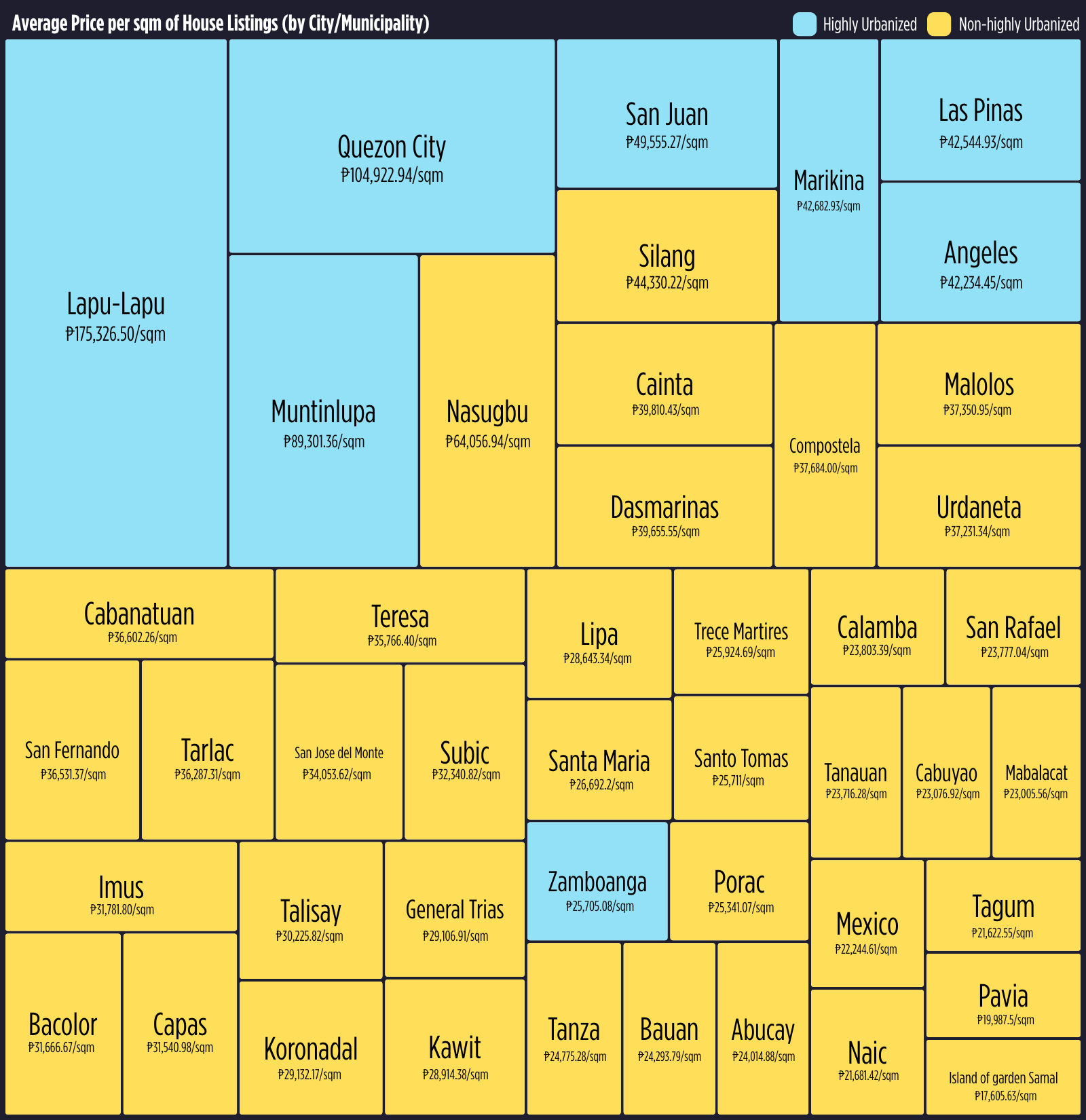
House Listings
This graph shows that for House Listings:
- Highest Average Price per sqm (Overall & Highly Urbanized):
The City of Lapu-lapu with ₱175,326.50/sqm
- Highest Average Price per sqm (Non-highly Urbanized):
The Municipality of Nasugbu with ₱64,056.94/sqm
- Lowest Average Price per sqm (Highly Urbanized):
The City of Zamboanga with ₱25,705.08/sqm
- Lowest Average Price per sqm (Overall & Non-highly
Urbanized):
The Island Garden City of Samal with ₱17,605.63/sqm
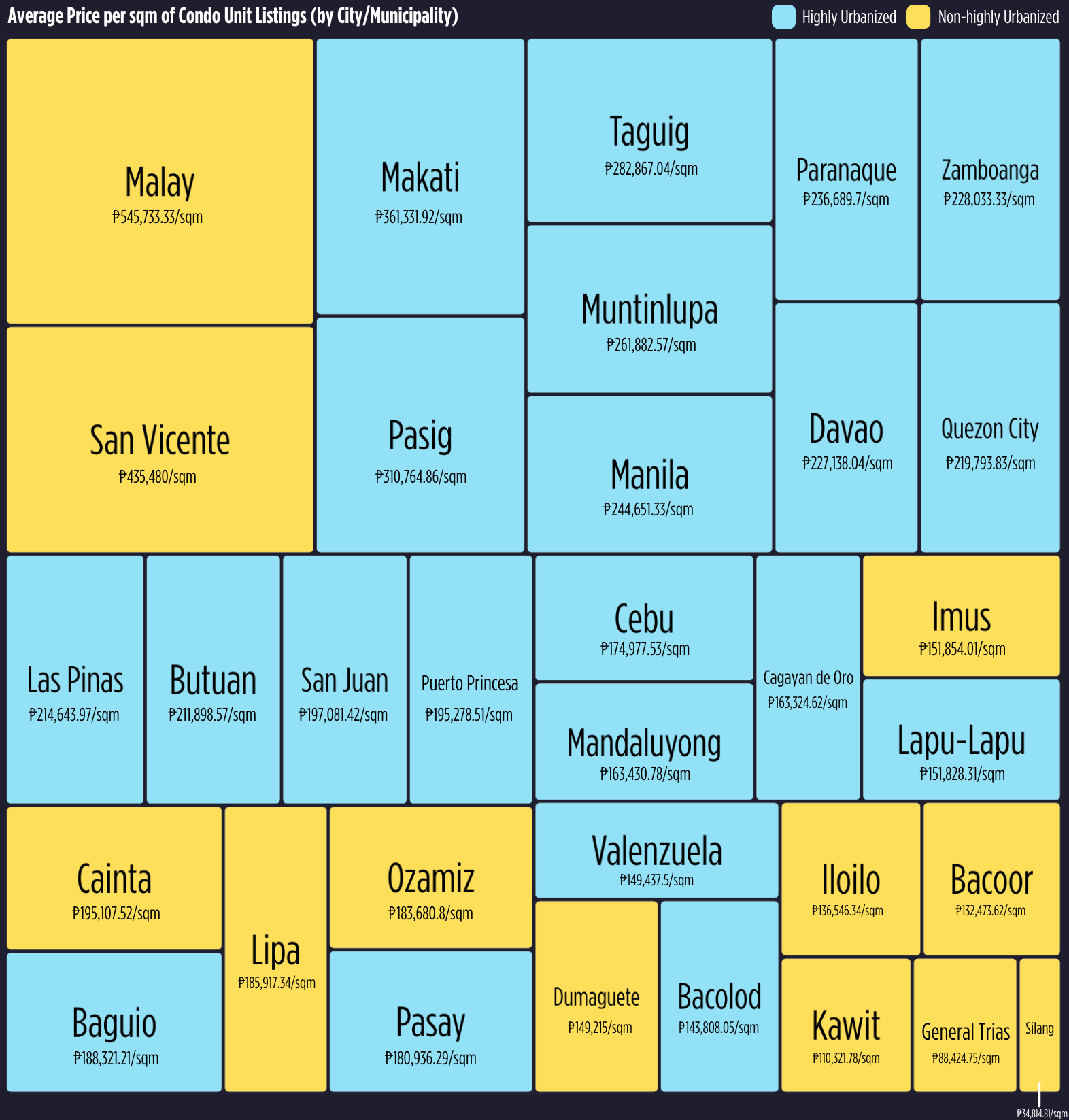
Condo Unit Listings
This graph shows that for Condo Unit Listings:
- Highest Average Price per sqm (Overall & Non-highly
Urbanized):
The Municipality of Malay with ₱545,733.33/sqm
- Highest Average Price per sqm (Highly Urbanized):
The City of Makati with ₱361,331.92/sqm
- Lowest Average Price per sqm (Highly Urbanized):
The City of Bacolod with ₱143,808.05/sqm
- Lowest Average Price per sqm (Overall & Non-highly
Urbanized):
The Municipality of Silang with ₱34,814.81/sqm

Lot Listings
This graph shows that for Lot Listings:
- Highest Average Price per sqm (Overall & Highly Urbanized):
The City of Muntinlupa with ₱435,000.00/sqm
- Highest Average Price per sqm (Non-highly Urbanized):
The City of Carmona with ₱54,296.00/sqm
- Lowest Average Price per sqm (Highly Urbanized):
The City of Zamboanga with ₱39,234.95/sqm
- Lowest Average Price per sqm (Overall & Non-highly
Urbanized):
The Municipality of Polomolok with ₱330.00/sqm
Is there a notable variation in the price-to-floor area ratio among different types of properties in different Philippine locations?
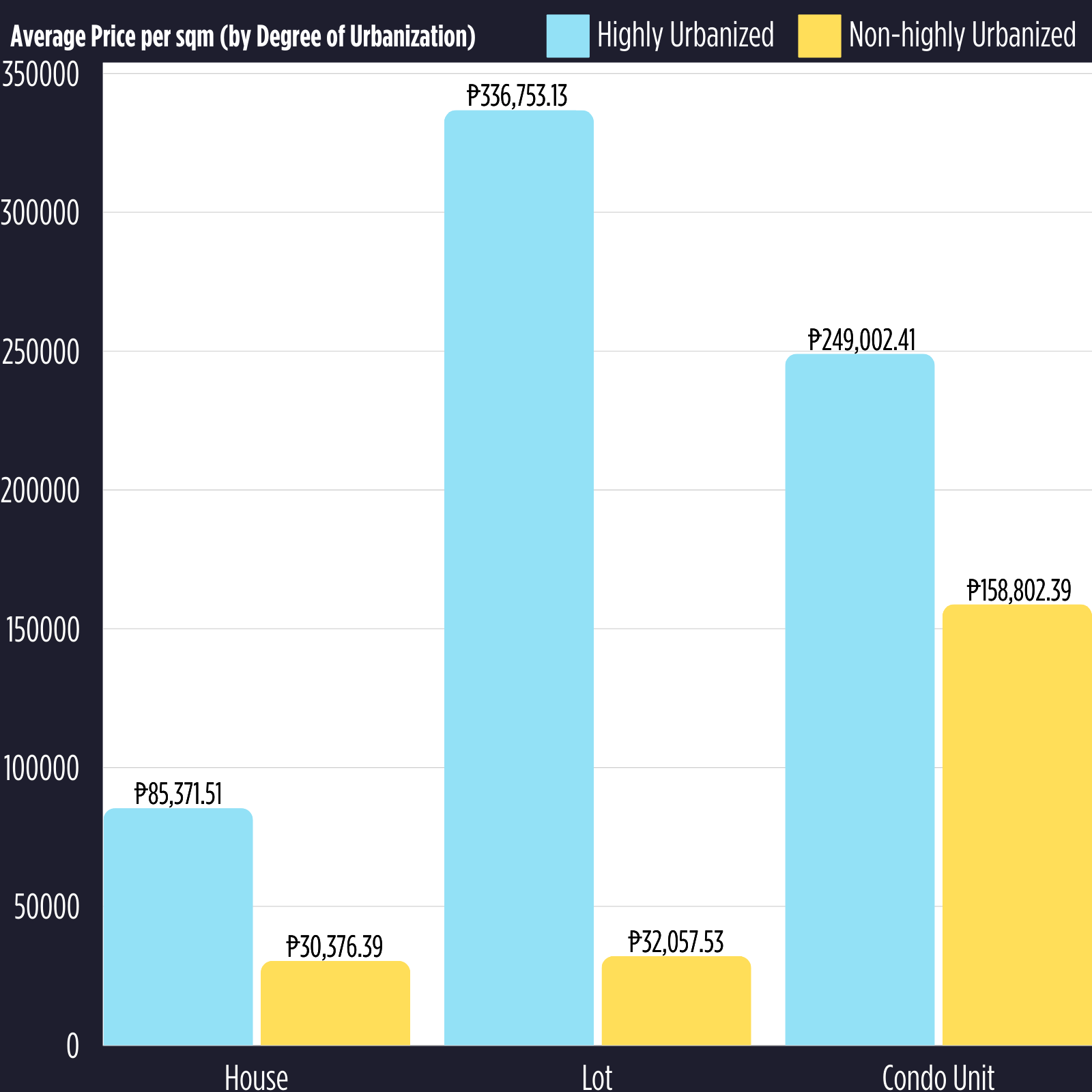
Insights
This graph shows that, on average:
- House Listings in Highly Urbanized Locations are more expensive than in Non-highly Urbanized Locations by ₱54,995.12 (~2.81x more).
- Lot Listings in Highly Urbanized Locations are more expensive than in Non-highly Urbanized Locations by ₱304,695.60 (~10.50x more).
- Condo Unit Listings in Highly Urbanized Locations are more expensive than in Non-highly Urbanized Locations by ₱90,200.02 (~1.57x more).
Statistical Test
We want to test if there is a significant difference in the average price per sqm in highly urbanized cities vs non-highly urbanized cities for different real estate types. Since we are dealing with a categorical variable (highly urbanized or not) and continuous variable (price per square meter), we can use either the independent t-test or the Mann-Whitney U test depending on the normality of our data.
House
We check the normality to determine which test to use.
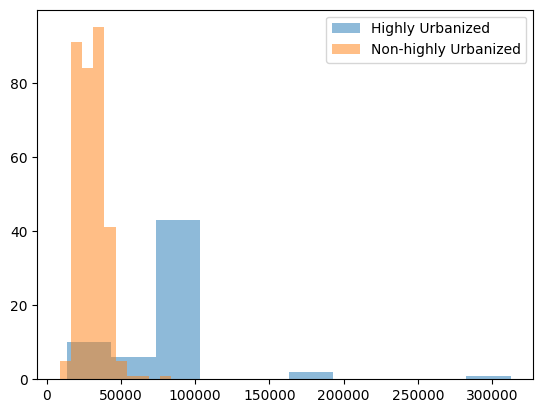
Since our histogram fails to show a bell curve, we cannot assume
normality of data.
Hence we use the Mann-Whitney U test to obtain a p-value.
With a significance level of 0.05 and a p-value of 1.5365x10-29, we reject our null hypothesis. Therefore, the price per sqm for houses in highly-urbanized areas are significantly different from less urbanized areas.
Condo Unit
We check the normality to determine which test to use.
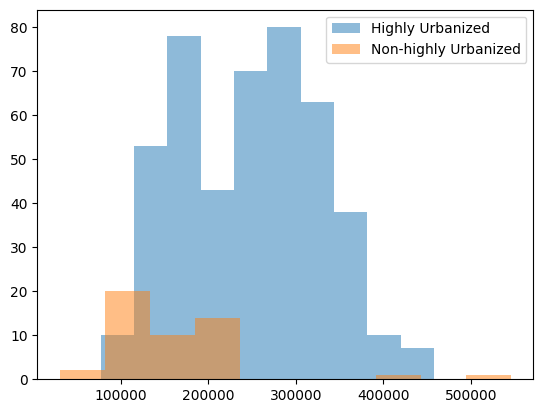
Since our histogram fails to show a bell curve, we cannot assume
normality of data.
Hence we use the Mann-Whitney U test to obtain a p-value.
With a significance level of 0.05 and a p-value of 1.7498x10-13, we reject our null hypothesis. Therefore, the price per sqm for condo units in highly-urbanized areas are significantly different from less urbanized areas.
Lot
We check the normality to determine which test to use.
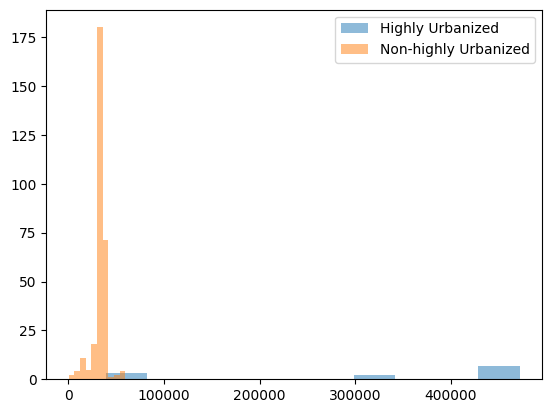
Since our histogram fails to show a bell curve, we cannot assume
normality of data.
Hence we use the Mann-Whitney U test to obtain a p-value.
With a significance level of 0.05 and a p-value of 9.0916x10-9, we reject our null hypothesis. Therefore, the price per sqm for lots in highly-urbanized areas are significantly different from less urbanized areas.
Results
From the statistical testing and EDA in the analysis, real estate is indeed more expensive in highly urbanized areas of the Philippines compared to the less urbanized areas regardless of real estate type. This underscores the influence of urbanization on property values, which can be crucial for urban planning and development policies especially in light of more people being unable to afford homes in urban centers.
Limitations
While the data scraped from Lamudi provided some insights on the current state of real estate pricing in different parts of the Philippines, it is important to note the limitations of said data. The team scraped all available 1500 available listings in Lamudi which was further reduced to 1196 viable listings. The limited data was not able to represent different types of real estate for many other cities within the Philippines. Lamudi is also only one real estate listing website among many others and its content can be limited to agents using said website.
Conclusion
The analysis confirms that real estate prices in the Philippines are significantly higher in highly urbanized areas compared to less urbanized regions, affecting all property types. This underscores the need for strategic urban planning to address housing affordability especially in urban centers in the country. The study was also able to pinpoint outliers with cheaper prices despite high urbanization, presenting investment opportunities for the public. Specific local factors, such as luxury developments in Alabang and tourism in Boracay and Palawan, are shown to influence the pricing of real estate regardless of urbanization. However, this promotes gentrification and leads to further housing problems by displacing lower-income residents. These insights can be further strengthened by incorporating a broader dataset for a more comprehensive analysis. Despite this, the study proves to be a start in analyzing the housing problem in the Philippines. Policymakers should develop and enforce urban planning strategies that address the disparities in real estate prices and ensure affordable housing in highly urbanized areas. Furthermore, the government must encourage inclusive development practices that prevent gentrification and displacement of lower-income residents, ensuring that all income groups have access to housing.
The Team
We are a team of 3 people studying data science that aim to use data science to gain insights about the country's current economical state. In our project, Real(i)ty Check, we aim to delve into the landscape of property prices in the Philippines. We are interested in how the urbanization of different Philippine cities has affected the price of real estate. With this, we hope that we are able to successfully identify the areas where housing is becoming unaffordable.

Ray Nuñez
a computer science student interested in data science, bioinformatics, and web development.

Chase Gonzaga
a computer science student interested in web development, game development, and data science.

Lara Punsalan
a computer science student interested in UI/UX, web development, and app development.